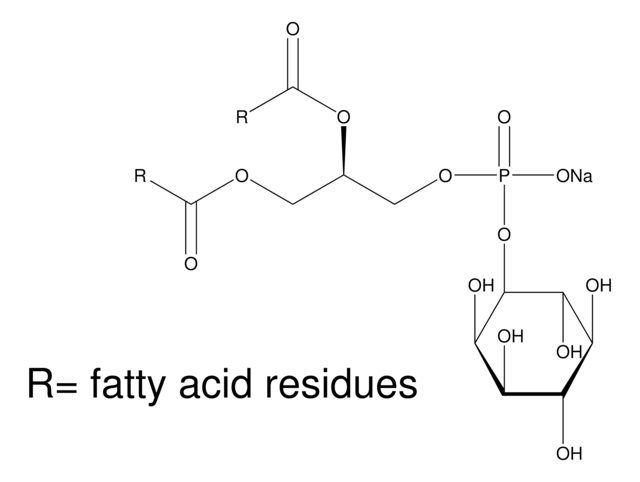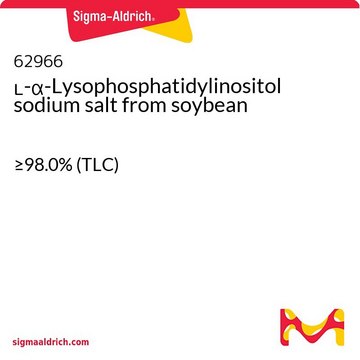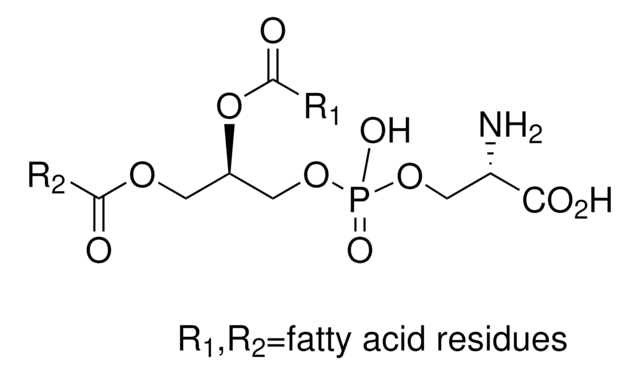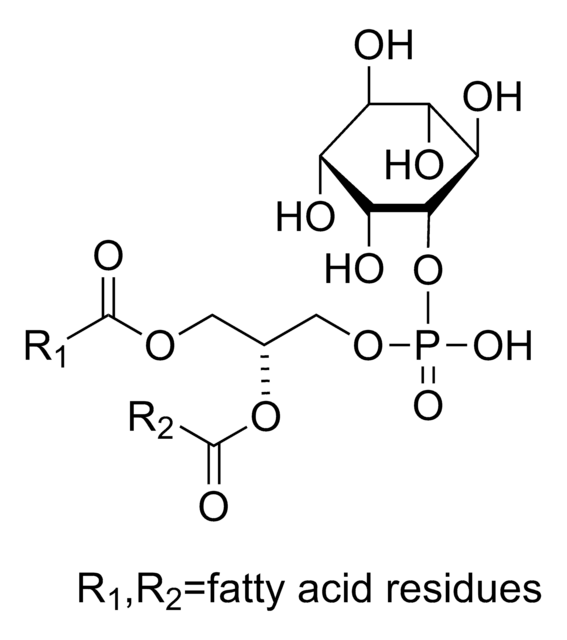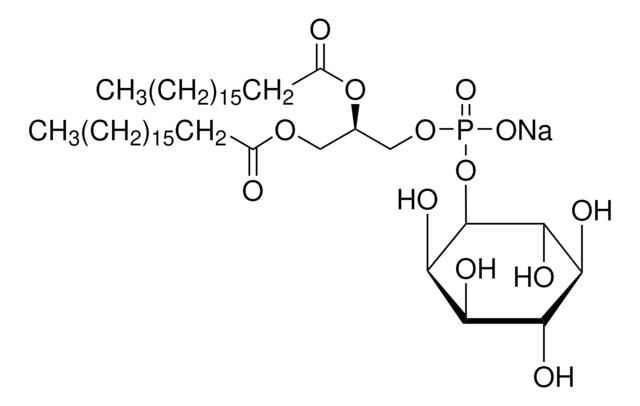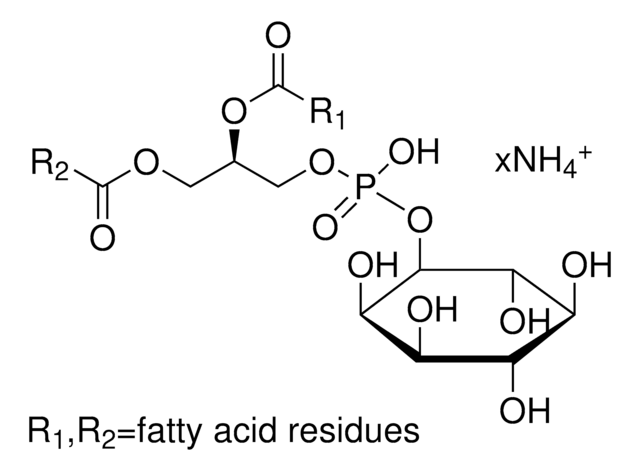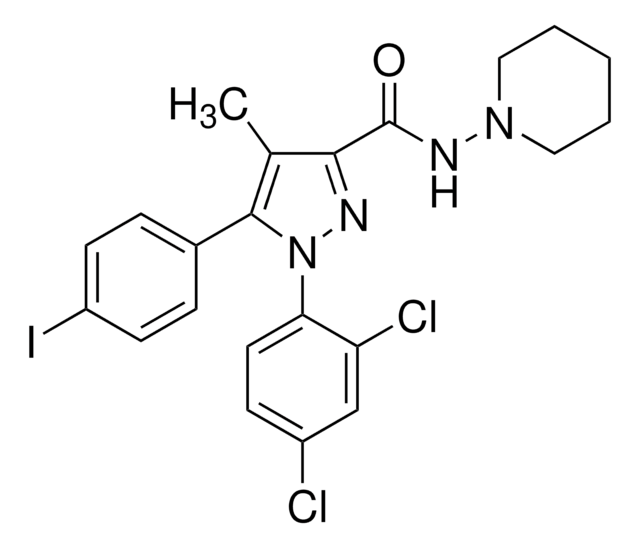L7635
L-α-Lysophosphatidylinositol sodium salt from Glycine max (soybean)
≥96%
Synonim(y):
1-Acyl-sn-glycero-3-phospho-(1-D-myo-inositol)
Zaloguj sięWyświetlanie cen organizacyjnych i kontraktowych
About This Item
Polecane produkty
pochodzenie biologiczne
soybean
Poziom jakości
Próba
≥96%
Formularz
powder
grupa funkcyjna
phospholipid
typ lipidu
phosphoglycerides
Warunki transportu
ambient
temp. przechowywania
−20°C
Zastosowanie
L-α-Lysophosphatidylinositol sodium salt from Glycine max (soybean) has been used as an agonist of G protein-coupled receptor 55 (GPR55).
Działania biochem./fizjol.
L-α-Lysophosphatidylinositols (LPI) functions as an endogenous ligand for putative cannabinoid receptor and G protein-coupled receptor 55 (GPR55). LPI plays a regulatory role in cell proliferation, migration and function. Increased circulatory levels of LPI has been observed in the obese patients. In addition, overexpression of LPI leads to the development of various types of cancers including ovarian and breast cancer. LPI can be used as a potential diagnostic and prognostic biomarker for ovarian cancer.
L-α-Lysophosphatidylinositols from Glycine max (soybean) are enriched with stearate and palmitate. Soybean Lysophosphatidylinositols may be compared with other lysophosphatidylinositol for biological activities which depend upon the identity of the acylated fatty acid.
Jakość
Contains primarily palmitic and stearic acids.
Uwaga dotycząca przygotowania
Prepared by the action of phospholipase A on L-α-phosphatidylinositol.
Ta strona może zawierać tekst przetłumaczony maszynowo.
Kod klasy składowania
11 - Combustible Solids
Klasa zagrożenia wodnego (WGK)
WGK 3
Temperatura zapłonu (°F)
Not applicable
Temperatura zapłonu (°C)
Not applicable
Środki ochrony indywidualnej
Eyeshields, Gloves, type N95 (US)
Wybierz jedną z najnowszych wersji:
Masz już ten produkt?
Dokumenty związane z niedawno zakupionymi produktami zostały zamieszczone w Bibliotece dokumentów.
Klienci oglądali również te produkty
Lysophosphatidylinositol stimulates [³⁵S]GTPγS binding in the rat prefrontal cortex and hippocampus.
Maria Luisa Rojo et al.
Neurochemical research, 37(5), 1037-1042 (2012-01-25)
Lysophosphatidylinositol (LPI) is a biologically active lipid that produces a number of responses in cultured cells, and has been suggested to have neuroprotective properties in vivo. Some of the actions of LPI are mediated by G-protein coupled receptors, but it
The L-alpha-lysophosphatidylinositol/GPR55 system and its potential role in human obesity
Moreno-Navarrete J, et al.
Diabetes, 61(2), 281-291 (2012)
The endocannabinoids anandamide and virodhamine modulate the activity of the candidate cannabinoid receptor GPR55
Sharir H, et al.
Journal of Neuroimmune Pharmacology, 7(4), 856-865 (2012)
Haleli Sharir et al.
Journal of neuroimmune pharmacology : the official journal of the Society on NeuroImmune Pharmacology, 7(4), 856-865 (2012-03-29)
The role of cannabinoid receptors in inflammation has been the topic of many research endeavors. Despite this effort, to date the involvement of the endocannabinoid system (ECS) in inflammation remains obscure. The ambiguity of cannabinoid involvement may be explained by
A novel biological role for the phospholipid lysophosphatidylinositol in nociceptive sensitization via activation of diverse G-protein signaling pathways in sensory nerves in vivo
Gangadharan V, et al.
Pain, 154(12) (2013)
Nasz zespół naukowców ma doświadczenie we wszystkich obszarach badań, w tym w naukach przyrodniczych, materiałoznawstwie, syntezie chemicznej, chromatografii, analityce i wielu innych dziedzinach.
Skontaktuj się z zespołem ds. pomocy technicznej